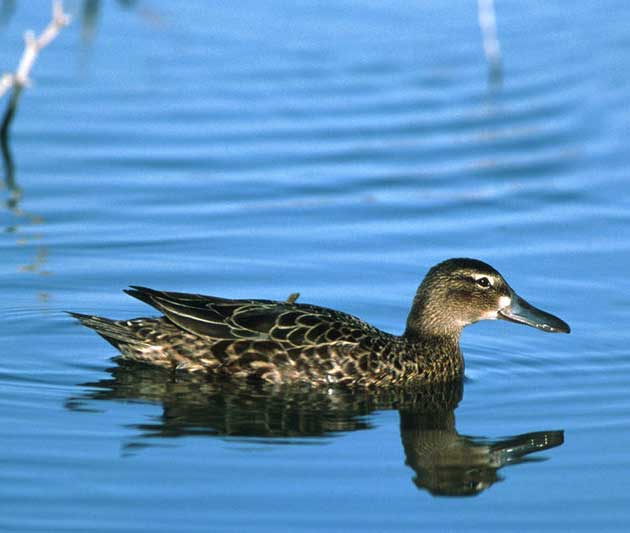
Spatula cyanoptera, US Fish and Wildlife Service
Superregnum: Eukaryota
Cladus: Unikonta
Cladus: Opisthokonta
Cladus: Holozoa
Regnum: Animalia
Subregnum: Eumetazoa
Cladus: Bilateria
Cladus: Nephrozoa
Superphylum: Deuterostomia
Phylum: Chordata
Subphylum: Vertebrata
Infraphylum: Gnathostomata
Megaclassis: Osteichthyes
Cladus: Sarcopterygii
Cladus: Rhipidistia
Cladus: Tetrapodomorpha
Cladus: Eotetrapodiformes
Cladus: Elpistostegalia
Superclassis: Tetrapoda
Cladus: Reptiliomorpha
Cladus: Amniota
Classis: Reptilia
Cladus: Eureptilia
Cladus: Romeriida
Subclassis: Diapsida
Cladus: Sauria
Infraclassis: Archosauromorpha
Cladus: Crurotarsi
Divisio: Archosauria
Cladus: Avemetatarsalia
Cladus: Ornithodira
Subtaxon: Dinosauromorpha
Cladus: Dinosauriformes
Cladus: Dracohors
Cladus: Dinosauria
Ordo: Saurischia
Cladus: Eusaurischia
Subordo: Theropoda
Cladus: Neotheropoda
Cladus: Averostra
Cladus: Tetanurae
Cladus: Avetheropoda
Cladus: Coelurosauria
Cladus: Tyrannoraptora
Cladus: Maniraptoromorpha
Cladus: Maniraptoriformes
Cladus: Maniraptora
Cladus: Pennaraptora
Cladus: Paraves
Cladus: Eumaniraptora
Cladus: Avialae
Infraclassis: Aves
Cladus: Euavialae
Cladus: Avebrevicauda
Cladus: Pygostylia
Cladus: Ornithothoraces
Cladus: Ornithuromorpha
Cladus: Carinatae
Parvclassis: Neornithes
Cohors: Neognathae
Cladus: Pangalloanserae
Cladus: Galloanseres
Ordo: Anseriformes
Familia: Anatidae
Genus: Spatula
Species: Spatula cyanoptera
Subspecies: S. c. borreroi – S. c. cyanoptera – S. c. orinoma – S. c. septentrionalium – S. c. tropica
Name
Spatula cyanoptera Vieillot, 1816
Synonyms
Anas cyanoptera (protonym)
References
Vieillot, L.J.P. 1816. Nouveau Dictionnaire d’Histoire naturelle, appliquée aux arts, à l'agriculture, à l'économie rurale et domestique, à la médecine, etc. Par une société de naturalistes et d'agriculteurs. Avec des figures tirées des trois règnes de la nature. Tome 5. 614 pp. + 9 tt. Déterville, Paris. 104 BHL Reference page.
IUCN: Spatula cyanoptera (Least Concern)
Vernacular names
العربية: بط بري سينامون
български: Канелено бърне
català: Xarxet canyella
čeština: Čírka skořicová
Cymraeg: Corhwyaden winau America
dansk: Kaneland
Deutsch: Zimtente
English: Cinnamon Teal
Esperanto: Cinamokapa anaso
español: Cerceta colorada
فارسی: خوتکای دارچینی
suomi: Punatavi
français: Sarcelle cannelle
עברית: ברווז קינמון
magyar: Fahéjszínű réce
italiano: Alzavola cannella
日本語: アカシマアジ
Plattdüütsch: Kaneelaant
Nederlands: Kaneeltaling
norsk: Kaneland
Diné bizaad: Naalʼeełí niłhinígíí
polski: Cynamonka
português do Brasil: Marreca-colorada
português: Marreca-colorada
Runa Simi: Puka pili
русский: Коричневый чирок
slovenčina: Kačica škoricová
svenska: Kanelårta
中文: 桂红鸭
The cinnamon teal (Spatula cyanoptera) is a species of duck found in western North and South America. It is a small dabbling duck, with bright reddish plumage on the male and duller brown plumage on the female. It lives in marshes and ponds, and feeds mostly on plants.
Description
The adult male has a cinnamon-red head and body with a brown back, a red eye and a dark bill. The adult female has a mottled brown body, a pale brown head, brown eyes and a grey bill and is very similar in appearance to a female blue-winged teal; however its overall color is richer, the lores, eye line, and eye ring are less distinct. Its bill is longer and more spatulate. Male juvenile resembles a female cinnamon or blue-winged teal but their eyes are red.[2][3] They are 16 in (41 cm) long, have a 22-inch (560 mm) wingspan, and weigh 14 oz (400 g).[3] They have 2 adult molts per year and a third molt in their first year.[3]
Distribution
Their breeding habitat is marshes and ponds in western United States and extreme southwestern Canada, and are rare visitors to the east coast of the United States.[3] Cinnamon teal generally select new mates each year. They are migratory and most winter in northern South America and the Caribbean,[4] generally not migrating as far as the blue-winged teal. Some winter in California and southwestern Arizona.[2] Two subspecies of cinnamon teal reside within the Andes of South America. The smaller sized S. c. cyanoptera is widespread within low elevations (<1000m) such as the coast of Peru and southern Argentina, whereas the larger size subspecies S. c. orinomus occupies elevations of 3500–4600 meters in the central Andes.[5]
Behavior
Male
These birds feed by dabbling. They mainly eat plants; their diet may include molluscs and aquatic insects.
Taxonomy
They are known to interbreed with blue-winged teals,[2] which are very close relatives.
Subspecies are:
Spatula cyanoptera septentrionalium (Oberholser, 1906) northern cinnamon teal breeds from British Columbia to northwestern New Mexico, and they winter in northwestern South America.[6]
Spatula cyanoptera tropica (Snyder & Lumsden, 1951) tropical cinnamon teal occurs in the Cauca Valley and Magdalena Valley in Colombia.[6]
Spatula cyanoptera borreroi (Snyder & Lumsden, 1951) Borrero's cinnamon teal (possibly extinct) occurs in the eastern Andes of Colombia with records of apparently resident birds from northern Ecuador.[6] It is named for Colombian ornithologist José Ignacio Borrero.
Spatula cyanoptera orinoma (Snyder & Lumsden, 1951) Andean cinnamon teal occurs in the Altiplano of Peru, northern Chile and Bolivia.[6]
Spatula cyanoptera cyanoptera (Vieillot, 1816) Argentine cinnamon teal occurs in southern Peru, southern Brazil, Argentina, Chile, and the Falkland Islands.[6]
References
BirdLife International (2016). "Spatula cyanoptera". IUCN Red List of Threatened Species. 2016: e.T22680233A92851668. doi:10.2305/IUCN.UK.2016-3.RLTS.T22680233A92851668.en. Retrieved 12 November 2021.
Dunn, J (2006)
Floyd T (2008)
Herrera et al. (2006)
Wilson, Robert E.; Peters, Jeffrey L.; McCracken, Kevin G. (2012-08-10). "Genetic and Phenotypic Divergence Between Low- and High-Altitude Populations of Two Recently Diverged Cinnamon Teal Subspecies". Evolution. 67 (1): 170–184. doi:10.1111/j.1558-5646.2012.01740.x. ISSN 0014-3820. PMID 23289570. S2CID 8378355.
Clements, J (2007)
Works cited
Clements, James, (2007) The Clements Checklist of the Birds of the World, Cornell University Press, Ithaca
Dunn, J. & Alderfer, J. (2006) National Geographic Field Guide to the Birds of North America 5th Ed.
Floyd, T (2008) Smithsonian Field Guide to the Birds of North America HarperCollins, NY
Herrera, Néstor; Rivera, Roberto; Ibarra Portillo, Ricardo & Rodríguez, Wilfredo (2006): Nuevos registros para la avifauna de El Salvador. ["New records for the avifauna of El Salvador"]. Boletín de la Sociedad Antioqueña de Ornitología 16(2): 1–19. [Spanish with English abstract]PDF fulltext
Retrieved from "http://en.wikipedia.org/"
All text is available under the terms of the GNU Free Documentation License

